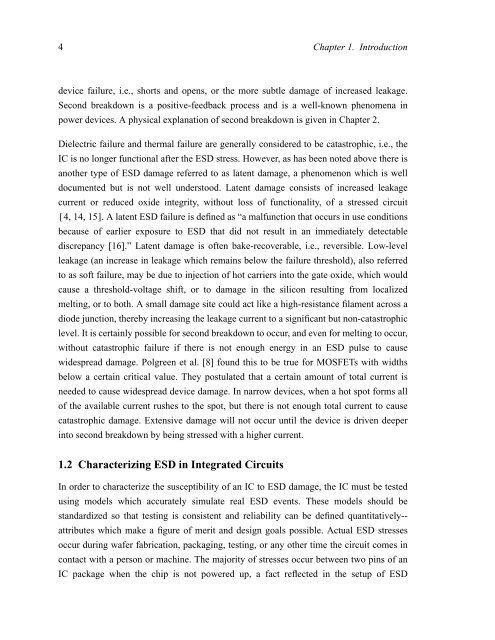characterization, modeling, and design of esd protection circuits
characterization, modeling, and design of esd protection circuits
characterization, modeling, and design of esd protection circuits
You also want an ePaper? Increase the reach of your titles
YUMPU automatically turns print PDFs into web optimized ePapers that Google loves.
4 Chapter 1. Introduction<br />
device failure, i.e., shorts <strong>and</strong> opens, or the more subtle damage <strong>of</strong> increased leakage.<br />
Second breakdown is a positive-feedback process <strong>and</strong> is a well-known phenomena in<br />
power devices. A physical explanation <strong>of</strong> second breakdown is given in Chapter 2.<br />
Dielectric failure <strong>and</strong> thermal failure are generally considered to be catastrophic, i.e., the<br />
IC is no longer functional after the ESD stress. However, as has been noted above there is<br />
another type <strong>of</strong> ESD damage referred to as latent damage, a phenomenon which is well<br />
documented but is not well understood. Latent damage consists <strong>of</strong> increased leakage<br />
current or reduced oxide integrity, without loss <strong>of</strong> functionality, <strong>of</strong> a stressed circuit<br />
[ 41415 , , ]<br />
. A latent ESD failure is defined as “a malfunction that occurs in use conditions<br />
because <strong>of</strong> earlier exposure to ESD that did not result in an immediately detectable<br />
discrepancy [16].” Latent damage is <strong>of</strong>ten bake-recoverable, i.e., reversible. Low-level<br />
leakage (an increase in leakage which remains below the failure threshold), also referred<br />
to as s<strong>of</strong>t failure, may be due to injection <strong>of</strong> hot carriers into the gate oxide, which would<br />
cause a threshold-voltage shift, or to damage in the silicon resulting from localized<br />
melting, or to both. A small damage site could act like a high-resistance filament across a<br />
diode junction, thereby increasing the leakage current to a significant but non-catastrophic<br />
level. It is certainly possible for second breakdown to occur, <strong>and</strong> even for melting to occur,<br />
without catastrophic failure if there is not enough energy in an ESD pulse to cause<br />
widespread damage. Polgreen et al. [8] found this to be true for MOSFETs with widths<br />
below a certain critical value. They postulated that a certain amount <strong>of</strong> total current is<br />
needed to cause widespread device damage. In narrow devices, when a hot spot forms all<br />
<strong>of</strong> the available current rushes to the spot, but there is not enough total current to cause<br />
catastrophic damage. Extensive damage will not occur until the device is driven deeper<br />
into second breakdown by being stressed with a higher current.<br />
1.2 Characterizing ESD in Integrated Circuits<br />
In order to characterize the susceptibility <strong>of</strong> an IC to ESD damage, the IC must be tested<br />
using models which accurately simulate real ESD events. These models should be<br />
st<strong>and</strong>ardized so that testing is consistent <strong>and</strong> reliability can be defined quantitativelyattributes<br />
which make a figure <strong>of</strong> merit <strong>and</strong> <strong>design</strong> goals possible. Actual ESD stresses<br />
occur during wafer fabrication, packaging, testing, or any other time the circuit comes in<br />
contact with a person or machine. The majority <strong>of</strong> stresses occur between two pins <strong>of</strong> an<br />
IC package when the chip is not powered up, a fact reflected in the setup <strong>of</strong> ESD
















